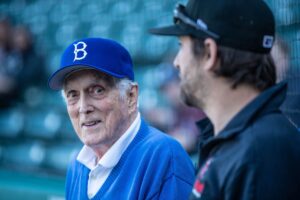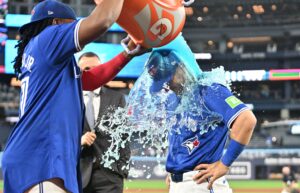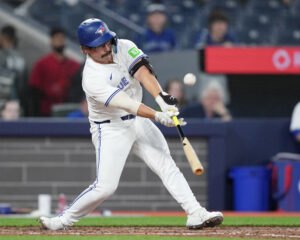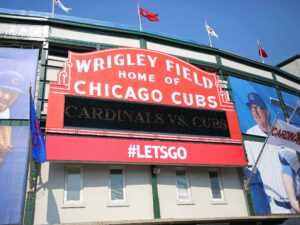The Milwaukee Brewers made three big trades during July. They acquired third baseman Mike Moustakas, second baseman Jonathan Schoop, and reliever Joakim Soria in three separate deals. It was a much more active deadline for the Brewers than in prior seasons, but was that actually a good thing? Right now, the acquisitions that David Stearns made have not helped his team very much at all.
Milwaukee Brewers Deadline Moves Haven’t Worked
The Brewers Didn’t Get a Starter, Here’s Why
Stearns correctly identified that his club needed an infielder (or two) and an extra bullpen arm. He made moves to address those needs. Many fans scratched their heads when Stearns did not trade for a starting pitcher. However, not trading for one of the available starters at the time was the right move. Something important to remember is that there were no real starting pitching upgrades available on the trade market.
Here is what the Brewer rotation looked like on the day of the deadline:
Jhoulys Chacin: 3.45 ERA / 3.90 FIP
Chase Anderson: 3.69 ERA / 5.00 FIP
Junior Guerra: 3.43 ERA / 4.11 FIP
Freddy Peralta: 3.61 ERA / 3.43 FIP
Wade Miley: 1.53 ERA / 3.63 FIP
Here are the starting pitchers who were available on the trade market:
Chris Archer: 4.31 ERA / 3.62 FIP
Kevin Gausman: 4.43 ERA / 4.58 FIP
Dylan Bundy: 4.53 ERA / 5.00 FIP
Matt Harvey: 4.44 ERA / 4.66 FIP
Nathan Eovaldi: 4.26 ERA / 4.28 FIP
Cole Hamels: 4.72 ERA / 5.00 FIP
J.A. Happ: 4.18 ERA / 3.84 ERA
Marco Estrada: 4.90 ERA / 4.78 FIP
Dan Straily: 4.41 ERA / 5.55 FIP
None of those arms represented upgrades over the current rotation. Rather, many of them were downgrades. It would make no sense to give something up for a pitcher who had performed worse than the five arms that the Brewers were rolling with. The Mets weren’t willing to deal Jacob deGrom, Noah Syndergaard, or Zack Wheeler unless it was an extreme overpay. The Twins also decided against dealing Kyle Gibson. All that was left was a collection of mediocre or even very poor starting pitchers.
The Brewers needed offense, and Stearns addressed it. The only problem is that Stearns might have picked the wrong offensive players to acquire.
Moustakas and Schoop Have Underperformed
The early returns on Moustakas have been mixed. Through 92 plate appearances, Moustakas has been a below-average hitter for the Brewers. He’s carrying a poor .709 OPS and wRC+ currently pegs him as a below-average hitter. Despite being brought in for his power bat, he’s managed just a mere .383 slugging percentage and has hit just two home runs. Since coming over to Milwaukee, his hard contact rate has nosedived (44% to 33%) and his line drive rate is down by about five percent. It is entirely possible that Moustakas will go on a tear in the coming weeks, but so far he hasn’t given the Brewers what they were hoping to get from him.
Schoop has been an absolute disaster in his young tenure in a Brewers uniform. He’s getting on base at an abysmal .207 clip and has an ugly .475 OPS in 58 plate appearances. He hit first home run with the Brewers on Tuesday, but it’s going to take more than that for him to make up for his practically nonexistent production thus far. Schoop is controlled through next season under arbitration, but his terrible start has led the Brewers to reportedly consider flipping him in the off-season.
The Brewers Ignored Schoop’s Glaring Weaknesses
Even before the Brewers dealt for Schoop, there were clear holes in his game. He had a .271 on-base percentage at the time of the deal. Schoop also had a career .296 on-base percentage, 3.7 percent walk rate, and 98 wRC+. While he hits for power, his lack of patience limits his upside.
Schoop’s awful plate discipline means that he relies almost exclusively on power to provide value. Schoop’s power was down this season. His slugging percentage dropped by over 50 points from the previous season. His poor plate discipline was also coming back to haunt him, as he carried a horrendous .273 OBP before the trade. Most concerningly, he was making hard contact just 26.6% of the time, down from 36.1% the year prior.
The red flags were there. Yet Stearns and his brass ignored them. They also made the trade right as the deadline hit, hinting that it may have been more of a desperation move than anything else.
Schoop is obviously not as bad of a hitter as he has been to start his Brewers career. Things will get better, but no one should be expecting him to turn into anything more than a nearly average hitter.
Soria Injured
The book is still out on Soria, as he’s missed over a week with a groin injury. He struck out six through his first 5 2/3 innings of work, but also walked three and allowed four hits. He’s likely to return in the coming days and figures to be a big part of the Brewer bullpen down the stretch. Before his injury, he had posted a combined 2.44 ERA and 11.17 K/9 over 44 innings between the White Sox and Brewers. Soria was a good addition, but how good remains to be seen. How soon can he return from injury and how much can he contribute to the Brewers’ postseason push?
The Defense has Been Compromised
After acquiring Moustakas, the Brewers shifted incumbent third baseman Travis Shaw to second base. Shaw has committed just one error at the keystone, but his lack of range and unfamiliarity with the position could very well cost the Brewers. Also playing out of position is the newly-acquired Schoop, who has been seeing time at shortstop. Schoop came up through the minor leagues as a shortstop but has been almost exclusively a second baseman in the majors. He has the arm to handle shortstop, but like Shaw his range is suspect.
The Brewers rank second in baseball with 87 defensive runs saved (DRS). Their excellent defense has been a big factor in their success, and it’s one of the reasons that many of their starters are out-performing their FIPs. Shifting from that defensive-minded approach and fielding a middle infield of two players who are out of position is very risky.
Final Evaluation
Let’s start with the positives. The Soria trade was a solid deal for the Brewers. The bullpen was getting thin due to injuries and reduced effectiveness. Stearns realized it and addressed it. Unfortunately, Soria is currently injured, but once he returns he figures to slot right back into a high leverage role. Stearns also wasn’t willing to overpay for a mediocre starting pitcher, which was smart on his part.
Now for the negatives. Moustakas and Schoop have not done much to help the offense and their additions have also created a messy-looking middle infield defense. Other targets that Stearns could’ve swung a deal for include Eduardo Escobar (who can play both third base and shortstop) or Brian Dozier (exclusively a second baseman). Both Dozier and Escobar have chipped in well above-average production for their new teams. Meanwhile, the Brewers are waiting for Moustakas and Schoop to boost the offense like they were expected to.
Stearns History
David Stearns has largely made excellent moves during his tenure as GM. He turned a rebuilding team into a contender years ahead of schedule. He claimed Jesus Aguilar off waivers from the Cleveland Indians and watched him turn into an All-Star. In the offseason, he traded for Christian Yelich and signed Lorenzo Cain. Both players have been key parts of the offense this season. However, it’s looking like Stearns targeted the wrong players at this year’s trade deadline. Whether or not Mike Moustakas and Jonathan Schoop can step up their games and boost the Brewers offense remains to be seen.
Main Photo:
Embed from Getty Images






